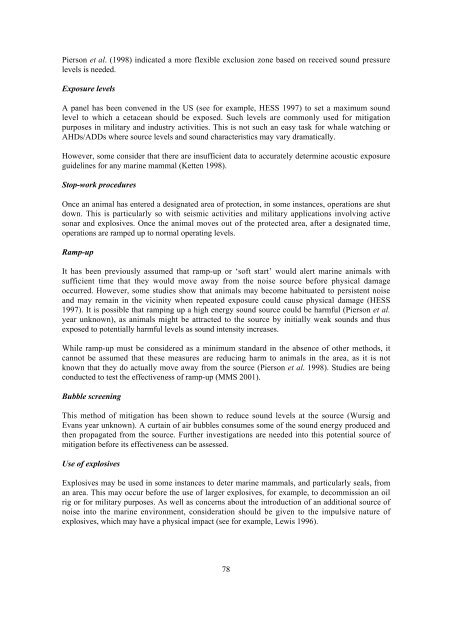Oceans of noise - Whale and Dolphin Conservation Society
Oceans of noise - Whale and Dolphin Conservation Society
Oceans of noise - Whale and Dolphin Conservation Society
- No tags were found...
Create successful ePaper yourself
Turn your PDF publications into a flip-book with our unique Google optimized e-Paper software.
Pierson et al. (1998) indicated a more flexible exclusion zone based on received sound pressurelevels is needed.Exposure levelsA panel has been convened in the US (see for example, HESS 1997) to set a maximum soundlevel to which a cetacean should be exposed. Such levels are commonly used for mitigationpurposes in military <strong>and</strong> industry activities. This is not such an easy task for whale watching orAHDs/ADDs where source levels <strong>and</strong> sound characteristics may vary dramatically.However, some consider that there are insufficient data to accurately determine acoustic exposureguidelines for any marine mammal (Ketten 1998).Stop-work proceduresOnce an animal has entered a designated area <strong>of</strong> protection, in some instances, operations are shutdown. This is particularly so with seismic activities <strong>and</strong> military applications involving activesonar <strong>and</strong> explosives. Once the animal moves out <strong>of</strong> the protected area, after a designated time,operations are ramped up to normal operating levels.Ramp-upIt has been previously assumed that ramp-up or ‘s<strong>of</strong>t start’ would alert marine animals withsufficient time that they would move away from the <strong>noise</strong> source before physical damageoccurred. However, some studies show that animals may become habituated to persistent <strong>noise</strong><strong>and</strong> may remain in the vicinity when repeated exposure could cause physical damage (HESS1997). It is possible that ramping up a high energy sound source could be harmful (Pierson et al.year unknown), as animals might be attracted to the source by initially weak sounds <strong>and</strong> thusexposed to potentially harmful levels as sound intensity increases.While ramp-up must be considered as a minimum st<strong>and</strong>ard in the absence <strong>of</strong> other methods, itcannot be assumed that these measures are reducing harm to animals in the area, as it is notknown that they do actually move away from the source (Pierson et al. 1998). Studies are beingconducted to test the effectiveness <strong>of</strong> ramp-up (MMS 2001).Bubble screeningThis method <strong>of</strong> mitigation has been shown to reduce sound levels at the source (Wursig <strong>and</strong>Evans year unknown). A curtain <strong>of</strong> air bubbles consumes some <strong>of</strong> the sound energy produced <strong>and</strong>then propagated from the source. Further investigations are needed into this potential source <strong>of</strong>mitigation before its effectiveness can be assessed.Use <strong>of</strong> explosivesExplosives may be used in some instances to deter marine mammals, <strong>and</strong> particularly seals, froman area. This may occur before the use <strong>of</strong> larger explosives, for example, to decommission an oilrig or for military purposes. As well as concerns about the introduction <strong>of</strong> an additional source <strong>of</strong><strong>noise</strong> into the marine environment, consideration should be given to the impulsive nature <strong>of</strong>explosives, which may have a physical impact (see for example, Lewis 1996).78




